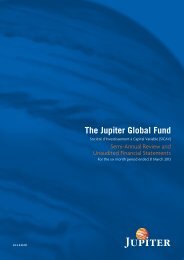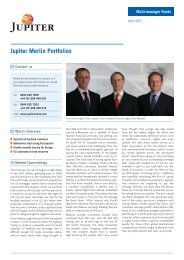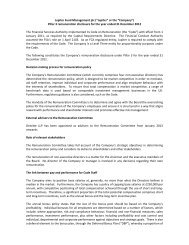The Jupiter Global Fund - Jupiter Asset Management
The Jupiter Global Fund - Jupiter Asset Management
The Jupiter Global Fund - Jupiter Asset Management
You also want an ePaper? Increase the reach of your titles
YUMPU automatically turns print PDFs into web optimized ePapers that Google loves.
the jupiter global fund<br />
<strong>Jupiter</strong> Strategic Total Return<br />
■■<strong>Jupiter</strong> Strategic Total Return Review of Portfolio as at 30 September 2012<br />
Performance<br />
NAV 30.09.12 30.09.11 % Change<br />
Class L US Dollar Shares USD 10.01 USD 9.90 1.11%<br />
Class L Euro Shares EUR 10.10 EUR 9.98 1.20%<br />
Class L Sterling Shares GBP 10.06 GBP 9.93 1.31%<br />
Class L Swiss Franc Shares CHF 9.89 CHF 9.84 0.51%<br />
Class I US Dollar Shares USD 10.09 USD 9.93 1.61%<br />
Class I Euro Shares EUR 10.21 EUR 10.03 1.79%<br />
Class I Sterling Shares GBP 10.16 GBP 9.97 1.91%<br />
Class I Swiss Franc Shares CHF 10.00 CHF 9.90 1.01%<br />
Performance Review<br />
In the period to 30 September 2012, the total return for the euro class<br />
was 1.20% compared with a return of 0.62% for its benchmark, the<br />
Euribor 1 month TR index. <strong>The</strong> Sterling, Swiss franc and US dollar<br />
classes’ total returns were respectively 1.31%, 0.51% and 1.11%<br />
compared with their benchmarks.<br />
Market Review<br />
In the period under review, markets were caught between opposing<br />
forces. One the one hand, the chronic inability of eurozone politicians<br />
to address the financial problems arising from their political<br />
Frankenstein made life unnecessarily harsher for millions of people.<br />
Austerity, once regarded as a medicine, became the poison that<br />
enervated the global economy. To counter this and the other<br />
contractionary forces arising from the mass deleveraging of<br />
commercial bank balance sheets, central banks unleashed a nearrolling<br />
programme of unorthodox monetary policies to manipulate the<br />
price of financial assets. However, despite renewed attempts by EU<br />
leaders to formulate a convincing response to the sovereign debt<br />
crisis such as installing technocratic governments in Greece and Italy,<br />
investors continued to worry about the impact on global growth.<br />
Investor sentiment was deeply pessimistic at the start of 2012. <strong>The</strong>re<br />
were well-founded fears that eurozone banks lacked the wherewithal<br />
to refinance maturing sovereign debt due to be rolled-over in the<br />
spring as several member states had lost effective access to bond<br />
markets. Circumstances soon changed. <strong>The</strong> European Central Bank<br />
(ECB)used its Long Term Refinancing Operation (LTRO) to offer<br />
commercial banks unlimited cheap three-year loans in exchange for<br />
collateral of varying quality. <strong>The</strong> yields on Italian and Spanish<br />
sovereign debt fell sharply as banks repurchased their debt, reducing<br />
yields and thus the cost of financing deficits. This backdoor<br />
monetisation was intended to buy time for politicians to agree on<br />
sensible fiscal policies but it also permitted core banks to divest<br />
themselves of peripheral debt and repatriate capital.<br />
<strong>The</strong> LTRO transformed a solvency crisis into a liquidity-driven rally.<br />
Equity markets responded positively aided by supportive US economic<br />
data and indications that China was easing fiscal policy. <strong>The</strong> UK<br />
economy remained weak and its budget deficit high.<br />
On 2 March 2012, all EU member states excepting the UK and the<br />
Czech Republic, signed the Fiscal Stability Treaty as a step towards<br />
fiscal union. This required them to run a budget that was either<br />
balanced or in surplus. Such requirements were likely to intensify preexisting<br />
recessionary conditions in some member states. Almost<br />
immediately, the new government in Spain announced it would flout<br />
these rules. Shortly afterwards it became the fourth country to require<br />
a bailout when it was forced to nationalise 90% of Bankia, a<br />
conglomerate of seven regional savings banks. Cyprus became the<br />
fifth just days before it took over the rotating presidency of the EU.<br />
A profound change in mood swept across markets over the summer<br />
after Mario Draghi said the ECB was prepared to do whatever it took<br />
to preserve the euro. Unlike equities, sovereign bond and currency<br />
markets continued to react to the intensity of Europe’s problems. An<br />
internal flight to safety saw yields for the two-year bonds of perceived<br />
havens (Germany, Austria, Netherlands, Finland and France) turn<br />
negative whereas debt servicing costs for Spain and Italy remained<br />
unsustainably high.<br />
Elsewhere in the world, central banks redoubled their efforts to boost<br />
growth in the face of a global slowdown. In September, the ECB’s<br />
commitment to unlimited, direct purchases of sovereign debt (subject<br />
to conditions) and the US Federal Reserve’s move to open-ended<br />
Quantitative Easing underpinned further gains in equities.<br />
Policy Review<br />
<strong>The</strong> aim of the <strong>Fund</strong> is to generate positive long-term returns across<br />
varying market conditions. In order to help achieve this while<br />
minimising volatility, we use a wide range of different, offsetting<br />
strategies to respond to dynamic changes in financial markets.<br />
In the period under review, the tendency of stock markets to switch<br />
almost daily between ‘risk on’ and ‘risk off’ modes created much<br />
turbulence. In order to eschew unwanted volatility we maintained our<br />
net equity exposure at a very low level, typically around 2.5%,<br />
preferring to gain equity exposure by holding convertible bonds since<br />
they also offered significant downside protection. Our cautious position<br />
in risk assets helped to protect the <strong>Fund</strong> in 2011 but also allowed it to<br />
gain ground in early 2012 and again in late summer/early autumn. <strong>The</strong><br />
other reason we maintained a low equity exposure was because we<br />
had sizable short positions in some government bonds and sovereign<br />
debt that we considered to be extremely overvalued. <strong>The</strong>re is a<br />
positive correlation between long equity and short bonds and we<br />
wished to avoid doubling up.<br />
81








